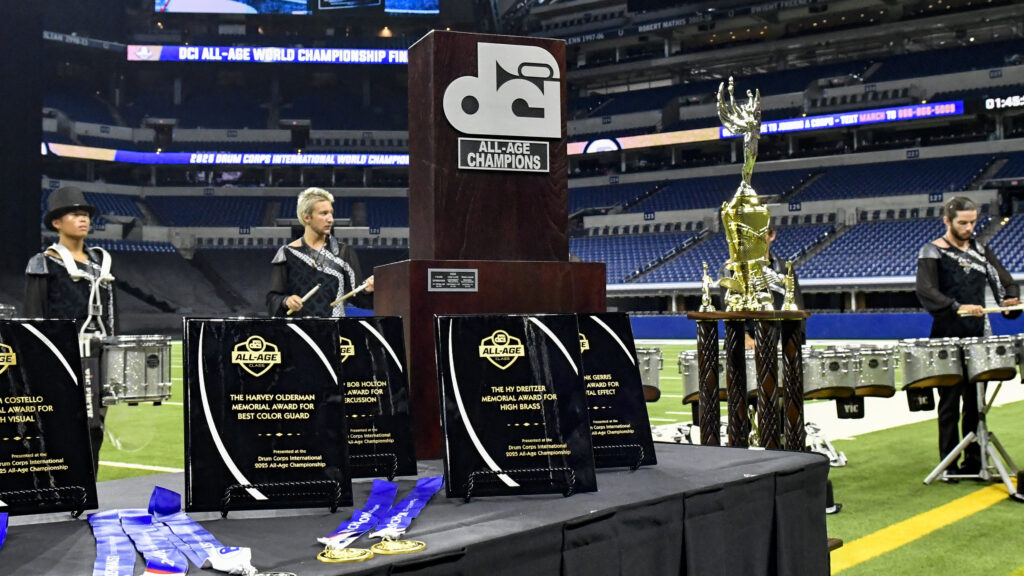Lucas Oil Stadium opened its doors to drum corps in 2009, and right away, there was a lot of drama between the corps trying to make it into Saturday night’s DCI World Championship Finals.
Although the Colts placed in the top-12 in four Semifinals captions, the corps fell three tenths of a point short of advancing. Edging the Iowa corps for the 12th-place spot was the Troopers, a corps who hadn’t been a finalist since 1986.
The Academy finished in 14th after falling out of the Semifinals in 2008, and the Madison Scouts finished 15th, out of the Finals for the third consecutive year. Crossmen and Spirit were the final two corps to advance from the Quarterfinals to the Semifinals. While 25 corps have advanced to the Semifinals since 2011, in 2009, only 17 corps were allowed to move on, which put the 18th place Mandarins just out of the Friday-night competition.
Mandarins’ 2009 production titled, “Absolute,” was filled with a variety of works representing the top favorites in a number of idioms. Dmitri Shostakovich’s “Festive Overture” of 1954 opened the show, filling the description of “Absolute Fanfare.”
Just days before a concert in celebration of the 37th anniversary of the Russian Revolution of 1917, the conductor of Moscow’s Bolshoi Theatre Orchestra realized he didn’t have a suitable new work to open the concert. Upon being asked to write such a work, Shostakovich finished the overture in just three days.
The end of the Mandarins’ opening fanfare introduced blazing yellow flags with various swirling figures of muted colors that were to be prominent throughout the rest of the jubilant opener.

Next was the segment of the show known as “Absolute Passion,” filled by the searing sensuality of Astor Piazzolla’s “Libertango,” written in 1974. The title of the selection combines the Spanish word for “liberty” with the word, “tango,” symbolizing Piazzola’s departure from the restrictions of the classical styles of the traditional Argentine tango. The piece is the composer’s best-known work and has appeared on more than 500 commercial recordings.
The color guard members proceeded to remove their purple vests worn as part of their costuming for the opener, to reveal open red vests that matched red flags decorated with the same type of muted-colored swirling designs as the previous flags. Sabers were also added to the guard equipment. For the ending of the piece, the entire section spun the red flags as the brass players blared the intensely romantic melody as if shouting the music so it was heard outside the stadium.
The next two show segments were titled “Absolute Joy” and “Absolute Rhythm,” comprised of two movements from Ludwig van Beethoven’s massively famous “Symphony No. 9” of 1824, his final symphony that was written after he became profoundly deaf. Also known as the “Choral Symphony,” the epic work was the first symphony written by a major composer to utilize voices, which were saved for the final “Ode to Joy” movement. The symphony also featured the largest orchestra ever assembled by Beethoven, who, prior to appearing as the conductor for the premiere performance in Vienna, hadn’t appeared on a podium in 12 years.

The corps’ “Absolute Joy” segment was based on that final “Ode to Joy” movement, Beethoven’s hymn of universal brotherhood that itself was based on a 1785 poem by German poet Friedrich Schiller. Huge pale lime-yellow flags were decorated with a swirling design reminiscent of that of the earlier flags.
This movement segued into “Absolute Rhythm,” a percussion feature from the symphony’s second movement. Light blue flags, again with the same design as earlier silks, were accompanied with tall, thick sticks with short light blue ribbons at the top. The color guard members added tall feathers sticking out of headbands for another new look to underscore the segment.
The final section of the show was “Absolute Velocity,” utilizing the third and final lively fast-paced movement of Philip Sparke’s “Partita,” originally written in 1989 for a Norwegian championship brass band. The entire color guard section, whose members were now wearing skirts of wide gold and purple strips around their waist, utilized rifles for the first half of the piece. For the last half minute, the entire section picked up white flags emblazoned with the same design as seen throughout the show, this time the swirls in bright celebratory colors, as the rapid passages in the horns hurtled to an exhilarating conclusion.
For this week only, you can save on the DVD that contains this complete Mandarins performance, along with all corps from Volume II of the 2009 DCI World Championship DVD set.
(Available this week only for 20% off)
DVD discount offer ends Monday, March 28, 2016.

Michael Boo was a member of the Cavaliers from 1975-1977. He has written about the drum corps activity for more than 35 years and serves as a staff writer for various Drum Corps International projects. Boo has written for numerous other publications and has published an honors-winning book on the history of figure skating. As an accomplished composer, Boo holds a bachelor's degree in music education and a master's degree in music theory and composition. He resides in Chesterton, Indiana.





